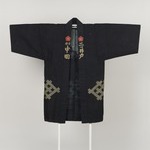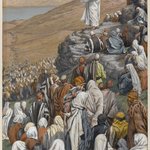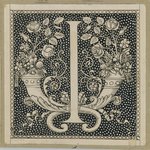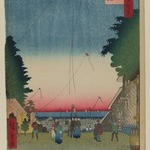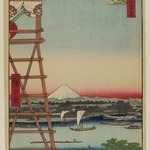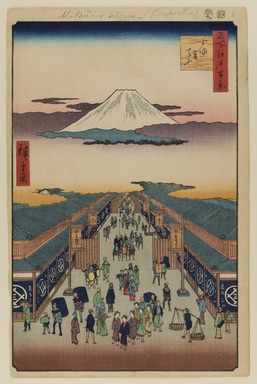
Suruga-cho, No. 8 in One Hundred Famous Views of Edo
Utagawa Hiroshige
Asian Art
What distinguishes Hiroshige's design in this print is its resolute symmetry, softened only by the irregular stylized cloud forms traditionally used in Japanese paintings to separate scenes in pictorial narratives. Here this compositional device focuses attention on Mount Fuji above and the urban bustle below in the street called Suruga-chō. Included in this scene is Japan's premier store, Echigoya, presently Mitsukoshi Department Store, still the most venerable of all the great merchandisers of Tokyo. It is identified by its crest, a circle around the characters for "three" and "well," which together read "Mitsui."
MEDIUM
Woodblock print
DATES
9th month of 1856
PERIOD
Edo Period, Ansei Era
DIMENSIONS
Image: 13 1/2 x 8 5/8 in. (34.3 x 21.9 cm)
Sheet: 14 3/16 x 9 1/8 in. (36 x 23.2 cm) (show scale)



MARKINGS
No publisher's seal visible, probably lost when left edge was trimmed.
SIGNATURE
Hiroshige-ga
COLLECTIONS
Asian Art
ACCESSION NUMBER
30.1478.8
CREDIT LINE
Gift of Anna Ferris
PROVENANCE
Prior to 1930, provenance not yet documented; by 1930, acquired by Anna Ferris of Summit, NJ; 1930, gift of Anna Ferris to the Brooklyn Museum.
Provenance FAQ
CATALOGUE DESCRIPTION
Mid-day scene looking part Edo's premier store, the Echigoya, (today Mitsukoshi Department Store and still the most venerable and most fashionable of all the great merchandisers of Tokyo). The name "Suruga-cho" was taken from the view itself, after the province (today Shizuoka Prefecture) in whose territory the summit of Mount Fuji lay. The circle design repeated along the store is the Mitsui (family name) trademark. Echigoya (the name designating the Mitsui family origins in the province which is now Niigata Prefecture) occupied both corners of Suruga-cho, as seen here from the main Nihonbashi thoroughfare. The store on the left (today the department store, renamed Mitsukoshi in 1904 by taking one character each from "Mitsui" and "Echigoya") dealt in silk fabrics, while the one on the right (today the Mitsui Bank) dealt in nonsilk fabrics. Among the diverse figures in the street are men shouldering large blue packs filled with dry goods ready for delivery. Note the "Genji" clouds (named after their use in illustrated versions of the "Tale of Genji"), one of several cloud forms used in traditional Japanese painting, originally to separate scenes in pictorial narration.
EXHIBITIONS
MUSEUM LOCATION
This item is not on view
CAPTION
Utagawa Hiroshige (Japanese, 1797–1858). Suruga-cho, No. 8 in One Hundred Famous Views of Edo, 9th month of 1856. Woodblock print, Image: 13 1/2 x 8 5/8 in. (34.3 x 21.9 cm). Brooklyn Museum, Gift of Anna Ferris, 30.1478.8 (Photo: Brooklyn Museum, 30.1478.8_PS20.jpg)
IMAGE
overall, 30.1478.8_PS20.jpg. Brooklyn Museum photograph, 2023
"CUR" at the beginning of an image file name means that the image was created by a curatorial staff member. These study images may be digital point-and-shoot photographs, when we don\'t yet have high-quality studio photography, or they may be scans of older negatives, slides, or photographic prints, providing historical documentation of the object.
RIGHTS STATEMENT
No known copyright restrictions
This work may be in the public domain in the United States. Works created by United States and non-United States nationals published prior to 1923 are in the public domain, subject to the terms of any applicable treaty or agreement.
You may download and use Brooklyn Museum images of this work. Please include caption information from this page and credit the Brooklyn Museum. If you need a high resolution file, please fill out our online application form (charges apply).
The Museum does not warrant that the use of this work will not infringe on the rights of third parties, such as artists or artists' heirs holding the rights to the work. It is your responsibility to determine and satisfy copyright or other use restrictions before copying, transmitting, or making other use of protected items beyond that allowed by "fair use," as such term is understood under the United States Copyright Act.
The Brooklyn Museum makes no representations or warranties with respect to the application or terms of any international agreement governing copyright protection in the United States for works created by foreign nationals.
For further information about copyright, we recommend resources at the United States Library of Congress, Cornell University, Copyright and Cultural Institutions: Guidelines for U.S. Libraries, Archives, and Museums, and Copyright Watch.
For more information about the Museum's rights project, including how rights types are assigned, please see our blog posts on copyright.
If you have any information regarding this work and rights to it, please contact copyright@brooklynmuseum.org.
RECORD COMPLETENESS
Not every record you will find here is complete. More information is available for some works than for others, and some entries have been updated more recently. Records are frequently reviewed and revised, and we welcome any additional information you might have.
















